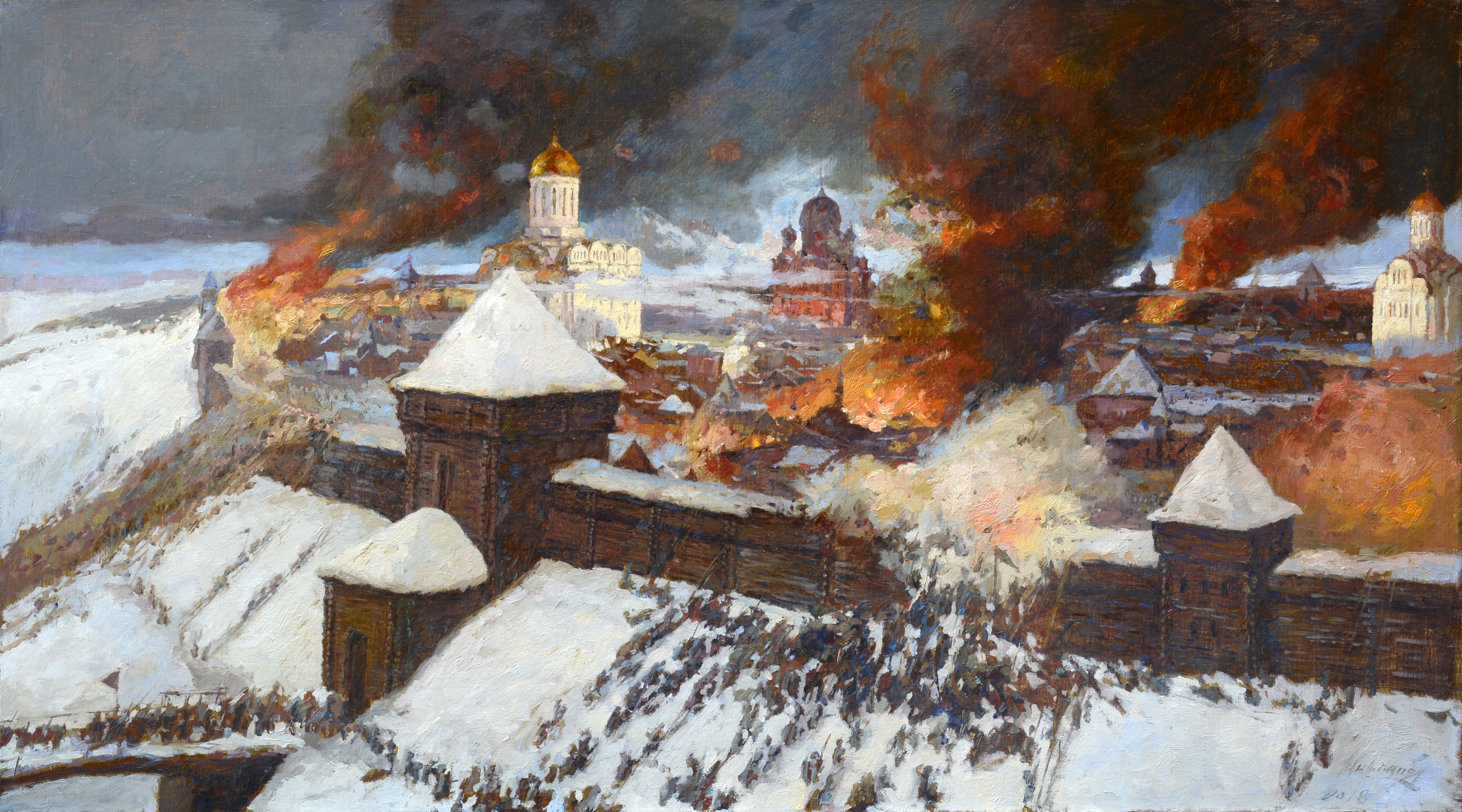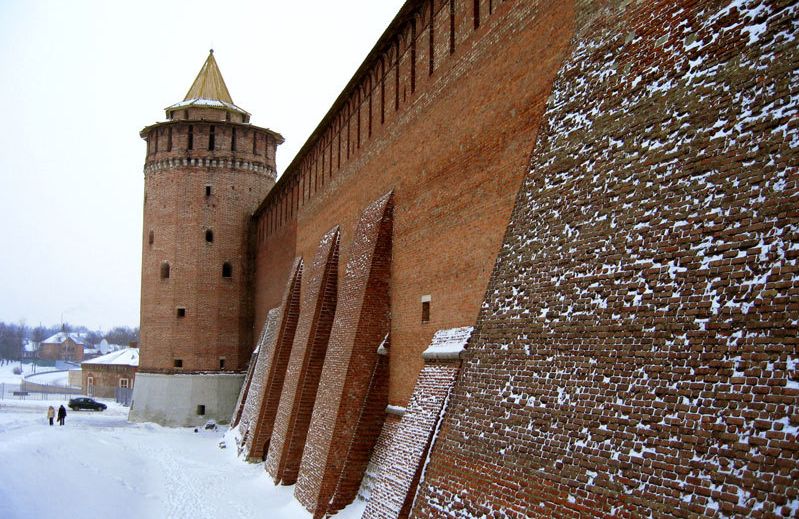|
Battle Of Voronezh River
The Battle of Voronezh River happened during the Mongol invasion of Kievan Rus'. The Principality of Ryazan was the first to be attacked. Opposing forces Size and composition of both armies can be estimated based on contemporary chronicles. Contemporary Mongol sources describe Batu as invading with 12-14 tumens, which would give him a nominal strength of 120.000-140.000 men, mostly nomad cavalry archers. However, tumens were often at less than full strength, some elite units with as few as 1.000 horsemen. On the Rus' side, contemporary sources mention only five princes by name, each of whom would be accompanied by his Druzhina, a small retinue of heavy cavalry. The princely retinue surpassed the Mongolian army in armament, both offensive and defensive. Massively heavy armor was used. However, these squads, as a rule, did not exceed the number of several hundred men, and were unsuitable for united actions under a single command. At the same time, the main part of the Rus' a ... [...More Info...] [...Related Items...] OR: [Wikipedia] [Google] [Baidu] |
Mongol Invasion Of Kievan Rus'
The Mongol Empire invaded and conquered much of Kievan Rus' in the mid-13th century, sacking numerous cities such as Principality of Ryazan, Ryazan, Principality of Yaroslavl, Yaroslavl, Principality of Pereyaslavl, Pereyaslavl and Vladimir-Suzdal, Vladimir, including the largest: Grand Principality of Kiev, Kiev (50,000 inhabitants) and Principality of Chernigov, Chernigov (30,000 inhabitants). The Siege of Kiev (1240), siege of Kiev in 1240 by the Mongols is generally held to mark the end of the state of Kievan Rus', which had already been undergoing Feudal fragmentation, fragmentation. Many other principalities and urban centres in the northwest and southwest escaped complete destruction or suffered little to no damage from the Mongol invasion, including Kingdom of Galicia–Volhynia, Galicia–Volhynia, Pskov Land, Pskov, Principality of Smolensk, Smolensk, Principality of Polotsk, Polotsk, Principality of Vitebsk, Vitebsk, and probably Vladimir-Suzdal, Rostov and Uglic ... [...More Info...] [...Related Items...] OR: [Wikipedia] [Google] [Baidu] |
Veliky Novgorod
Veliky Novgorod ( ; , ; ), also known simply as Novgorod (), is the largest city and administrative centre of Novgorod Oblast, Russia. It is one of the oldest cities in Russia, being first mentioned in the 9th century. The city lies along the Volkhov River just downstream from its outflow from Lake Ilmen and is situated on the M10 federal highway connecting Moscow and Saint Petersburg. UNESCO recognized Novgorod as a World Heritage Site in 1992. The city has a population of At its peak during the 14th century, the city was the capital of the Novgorod Republic and was one of Europe's largest cities. The "Великий" part was added to the city's name in 1999. Climate Veliky Novgorod has a humid continental climate (Köppen ''Dfb''). The city has warm summers with temperatures reaching over 30 °C (86 °F) and relatively cold winters with frequent snowfall. The lowest air temperature ever recorded is -45 °C (-49 °F). The warmest month is July with a d ... [...More Info...] [...Related Items...] OR: [Wikipedia] [Google] [Baidu] |
13th Century In Kievan Rus'
In music or music theory, a thirteenth is the Musical note, note thirteen scale degrees from the root (chord), root of a chord (music), chord and also the interval (music), interval between the root and the thirteenth. The thirteenth is most commonly major or minor . A thirteenth chord is the stacking of six (major third, major or minor third, minor) thirds, the last being above the 11th of an eleventh chord. Thus a thirteenth chord is a tertian (built from thirds) chord containing the interval of a thirteenth, and is an extended chord if it includes the ninth and/or the eleventh. "The jazzy thirteenth is a very versatile chord and is used in many genres." Since 13th chords tend to become unclear or confused with other chords when Inverted chord, inverted, they are generally found in root position. For example, depending on voicing (music), voicing, a major triad with an added major sixth (chord), sixth is usually called a sixth chord , because the sixth serves as a sub ... [...More Info...] [...Related Items...] OR: [Wikipedia] [Google] [Baidu] |
History Of Ryazan Oblast
Ryazan Oblast (, ) is a federal subject of Russia (an oblast). Its administrative center is the city of Ryazan, which is also the oblast's largest city. Geography Ryazan Oblast borders Vladimir Oblast (N), Nizhny Novgorod Oblast (NE), the Republic of Mordovia (E), Penza Oblast (SE), Tambov Oblast (S), Lipetsk Oblast (SW), Tula Oblast (W), and Moscow Oblast (NW). In terms of physical geography, Ryazan Oblast lies in the central part of the Russian Plain between the Central Russian and Volga uplands. The terrain is flat, with the highest point of no more than 300 m above sea level. Soils are podzolic and boggy on the left bank of the Oka, changing southward to more fertile podzolic and leached black-earths ( chernozyom). Hydrography Most of the Ryazan Oblast lies within the Volga basin, with the Oka the principal river of the area. History Human occupation of the area of the Ryazan Oblast dates from at least the Upper Paleolithic period. East Slavs, Volga Finnic, Tatar trib ... [...More Info...] [...Related Items...] OR: [Wikipedia] [Google] [Baidu] |
1237 In Europe
1 (one, unit, unity) is a number, numeral, and glyph. It is the first and smallest positive integer of the infinite sequence of natural numbers. This fundamental property has led to its unique uses in other fields, ranging from science to sports, where it commonly denotes the first, leading, or top thing in a group. 1 is the unit of counting or measurement, a determiner for singular nouns, and a gender-neutral pronoun. Historically, the representation of 1 evolved from ancient Sumerian and Babylonian symbols to the modern Arabic numeral. In mathematics, 1 is the multiplicative identity, meaning that any number multiplied by 1 equals the same number. 1 is by convention not considered a prime number. In digital technology, 1 represents the "on" state in binary code, the foundation of computing. Philosophically, 1 symbolizes the ultimate reality or source of existence in various traditions. In mathematics The number 1 is the first natural number after 0. Each natural number, ... [...More Info...] [...Related Items...] OR: [Wikipedia] [Google] [Baidu] |
Conflicts In 1237
Conflict may refer to: Social sciences * Conflict (process), the general pattern of groups dealing with disparate ideas * Conflict continuum from cooperation (low intensity), to contest, to higher intensity (violence and war) * Conflict of interest, involvement in multiple interests which could possibly corrupt the motivation or decision-making * Cultural conflict, a type of conflict that occurs when different cultural values and beliefs clash * Ethnic conflict, a conflict between two or more contending ethnic groups * Group conflict, conflict between groups * Intragroup conflict, conflict within groups * Organizational conflict, discord caused by opposition of needs, values, and interests between people working together * Role conflict, incompatible demands placed upon a person such that compliance with both would be difficult * Social conflict, the struggle for agency or power in something * Work–family conflict, incompatible demands between the work and family roles of a ... [...More Info...] [...Related Items...] OR: [Wikipedia] [Google] [Baidu] |
Battles Of The Mongol Invasion Of Kievan Rus'
A battle is an occurrence of combat in warfare between opposing military units of any number or size. A war usually consists of multiple battles. In general, a battle is a military engagement that is well defined in duration, area, and force commitment. An engagement with only limited commitment between the forces and without decisive results is sometimes called a skirmish. The word "battle" can also be used infrequently to refer to an entire operational campaign, although this usage greatly diverges from its conventional or customary meaning. Generally, the word "battle" is used for such campaigns if referring to a protracted combat encounter in which either one or both of the combatants had the same methods, resources, and strategic objectives throughout the encounter. Some prominent examples of this would be the Battle of the Atlantic, Battle of Britain, and the Battle of France, all in World War II. Wars and military campaigns are guided by military strategy, whereas batt ... [...More Info...] [...Related Items...] OR: [Wikipedia] [Google] [Baidu] |
Kolomna
Kolomna (, ) is a historic types of inhabited localities in Russia, city in Moscow Oblast, Russia, situated at the confluence of the Moskva River, Moskva and Oka Rivers, (by rail) southeast of Moscow. Population: History Mentioned for the first time in 1177, Kolomna was founded in 1140–1160 according to the latest archaeological surveys. Kolomna's name may originate from the Old East Slavic, Old Russian term for "on the bend (in the river)", especially as the old city is located on a sharp bend in the Moskva River, Moscow River. In January 1238, Kolomna was Siege of Kolomna, destroyed by a Mongol invasion of Kievan Rus', Mongol invasion. In 1301, Kolomna became the first town to be incorporated into the Moscow Principality. Like some other ancient Russian cities, it has a Kolomna Kremlin, kremlin, which is a citadel similar to the Moscow Kremlin, more famous one in Moscow and also built of red brick. The stone Kolomna Kremlin was built from 1525–1531 under the Russian Tsar ... [...More Info...] [...Related Items...] OR: [Wikipedia] [Google] [Baidu] |
Vladimir-Suzdal
The Principality of Suzdal, from 1157 the Grand Principality of Vladimir, commonly known as Vladimir-Suzdal, or simply Suzdalia, was a medieval principality that was established during the disintegration of Kievan Rus'. In historiography, the territory of the grand principality and the principalities that emerged from it is commonly denoted as northeast Russia or northeast Rus. Yuri Dolgorukiy, Yury Dolgoruky () moved his capital from Rostov, Yaroslavl Oblast, Rostov to Suzdal in 1125, following the death of his father. He ruled a principality that had become virtually independent. His son Andrey Bogolyubsky, Andrey () moved the capital to Vladimir, Russia, Vladimir and had Kiev sacked in 1169, leading to political power shifting to the north-east. Andrey's younger brother Vsevolod III () secured control of the throne, and following his death, a dynastic conflict ensued. Yuri II of Vladimir, Yury II () was killed during the Mongol invasion of Kievan Rus', Mongol invasions ... [...More Info...] [...Related Items...] OR: [Wikipedia] [Google] [Baidu] |
Pronsk
Pronsk () is the name of several inhabited localities in Ryazan Oblast, Russia. ;Urban localities *Pronsk, Pronsky District, Ryazan Oblast, a work settlement in Pronsky District Pronsky District () is an administrativeLaw #128-ZS and municipalLaw #89-OZ district (raion), one of the twenty-five in Ryazan Oblast, Russia. It is located in the west of the oblast. The area of the district is . Its administrative center An a ... ;Rural localities * Pronsk, Ukholovsky District, Ryazan Oblast, a '' selo'' in Konoplinsky Rural Okrug of Ukholovsky District {{SIA, populated places in Russia ... [...More Info...] [...Related Items...] OR: [Wikipedia] [Google] [Baidu] |
Murom
Murom (, ) is a historical types of inhabited localities in Russia, city in Vladimir Oblast, Russia, which sprawls along the west bank of the Oka River. It borders Nizhny Novgorod Oblast and is situated from the administrative center Vladimir, Russia, Vladimir. Its population as of the 2021 Russian census, 2021 Census was 107,497. History In the 9th century AD, the city marked the easternmost settlement of the East Slavs in the land of the Finnic Volga Finns, Muromians. The ''Primary Chronicle'' mentions it as early as AD 862. It is, thus, one of the oldest cities in Russia. Circa 900 AD, it was an important trading post from Volga Bulgaria to the Baltic Sea. Between AD 1010 and AD 1393, it was the capital of a separate principality, whose rulers included Saint Boris and Gleb, Gleb, assassinated in AD 1015 and canonized in AD 1071, Saint Prince Konstantin of Murom, Konstantin the Blessed, and Saints Peter and Fevronia of Murom, subjects of an opera by Nikolai Rimsky-Korsak ... [...More Info...] [...Related Items...] OR: [Wikipedia] [Google] [Baidu] |




